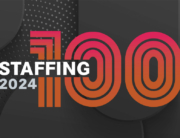For the past decade, technology has been moving at lightning speed. New products are enabling global firms to innovate and do business at a pace that is both exciting and challenging. This creates new opportunities for workforce planning, as well as talent sourcing and acquisition. As what the World Economic Forum has dubbed “The Fourth Industrial Revolution” picks up speed, the way businesses, technologies, geographies and people function and interact will be transformed. From social media sourcing to robotic recruiting, employers and staffing industries alike will need to keep a close watch to efficiently attract and retain the best talent.
Jim Lanzalotto, Senior Vice President of the Staffing and Healthcare business units for Monster Worldwide, has analyzed the landscape of evolving products to predict how technology trends will affect staffing firms and the clients they serve in terms of both getting qualified candidates and internal operations.
Q: What are the dominant technology trends currently affecting staffing firms, and how should they approach these technologies?
A: There are three main trends:
Mobile: More than 50 percent of all traffic to Monster comes from a mobile device. The issue for staffing companies is, how are they adapting to this change?
Staffing firms need to build their mobile solution around what the customer is using it for. It’s like any other product development environment — you need to start with the customer at the center of the conversation.
Data and the cloud: New developments offer the ability to have all your data in the cloud environment and the data warehouse — and to take that information and make it actionable.
The shift to the cloud is incredibly important because creating actionable business guidance requires a much smaller investment than in the past. Cloud technology allows you to store and analyze a lot of data. With that data, you can answer questions like where are your candidates coming from? Knowing that helps you move your investments around.
Social media: Recruiters who understand their markets best are most successful. Social media allows you to connect with talent in any number of ways and to nurture those relationships by giving candidates knowledge and positioning yourself as a thought leader.
Too many people communicate by doing nothing more than sending job leads — it tends to be a little monotonous and in some cases a little annoying. Instead, nurture those relationships with information on how to update your resume, for example. Make sure you’re a valuable resource.
Q: Why are technology trends important to the future of the staffing industry?
A: One reason is that you need to go where the candidate is, not wait for the candidate to come to you. Proactive outreach is so important in recruiting, and technology such as social media can help — as a recruiter, the most important thing you do is talk to your candidates — but you can’t reach all of them all the time. Using tools including social media is critically important.
The second reason to keep up with tech trends is that there is always going to be something next. Your ability to adopt emerging tools and adapt your business to them is critical. When vendor management systems came along at the turn of the century, the companies that adapted their businesses are the ones that succeeded.
It has to be part of your company’s DNA to see a technology, understand how it will impact you, adopt it into your business, and adapt the way you run your business.
Q: What’s an issue facing staffing companies that is affected by technology?
A: End-date management is one example: the ability to manage the end of an assignment so the consultant can be reassigned before going somewhere else. If you use your data effectively and use queries to get end dates 45 or 60 days out, you can communicate with your candidates and let them know what potential assignments you might have for them.
A lot of work goes into acquiring someone to work for a customer — you don’t want to have to do that again. If you can deliver that temporary worker to a new customer using that end date, how much more efficient will you be?
Q: How do advances in technology affect large corporations versus smaller businesses?
A: Smaller staffing firms (those with 25 recruiters and salespeople or fewer) can use these technologies to change the way they do business and to level the playing field a bit. They get greater reach, for example, by using social media to connect to people and build relationships.
Larger companies can make the investments that smaller companies may not be able to. For example, when VMS technologies were starting to come on the scene, larger companies were the ones to move into this area heavily and quickly. They were the initial investors. They can place their bets across a wide portfolio, and if something is promising, they can commercialize it and integrate it into their core business.
Q: How can staffing firms affordably align themselves to clients’ preferences when it comes to technology? How does this affect internal operations?
A: The key for companies of all sizes is to have somebody keep an eye on what’s going on in the greater technology marketplace. It shifts so quickly, and if you’re not watching what’s going on in adjacent markets, the business will change before you’re aware of it.
For example, when Monster started in 1994, we didn’t disrupt staffing companies — we disrupted newspapers. Before 1994, advertising was done via the newspapers. Companies that were aware of that change early on were able to dramatically reduce their costs.
Today, if you are able to use a tool like Facebook or Twitter as a way to nurture and build relationships with your candidates, that’s an advantage. You need to be aware of what’s going on in your adjacent markets, how that’s going to drive your success, and how you adapt your organization to it.
Q: Given the age of automation, what should the top priorities of staffing firm clients be today?
A: Like with any other business program, start with your customers. Learn what their priorities are and change your business to meet their needs.
For example, when I first started working with mobile technologies, a key question was how to use a Palm Pilot to help a customer do business? Now the question is how to help hiring managers place orders or review talent on any mobile device with immediate results.
My recommendation is to understand from your customers what they need and what they want to do in the future. You have to stay in touch with your customers and see what they’re looking for. However, you also have to drive the conversation. You have to innovate to be successful. You cannot just wait for your customers to tell you what to do.
Q: Looking ahead, are there other technology trends with future implications for the staffing industry?
A: Artificial intelligence is a very cool way for staffing companies to change the way we do things. Modeling your business using technology will make everyone smarter. And you can score candidates based on their attributes and abilities.
Virtual reality could also be a very interesting application. You can model different operating environments for people during an interview. Instead of using behavioral interview questions — “Give me an example of a time when…” — you can put a candidate into a virtual environment and see how they react. That type of technology application will dramatically disrupt the way candidates are interviewed.







